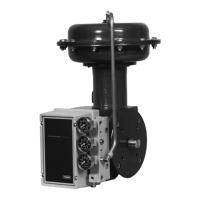Type 1051 & 1052 Styles H & J
20
as close as possible with the hole in the rod end
bearing (key 17).
d. Temporarily rotate the lever and output shaft
until the rod end bearing no longer interferes with
further installation of the lever. Then, slide the lever
as far as it can go onto the output shaft. Clamp the
lever to the output shaft with the cap screw (key
28). Tighten the cap screw to the torque value
listed in table 7.
e. Rotate the lever and output shaft back to the
original position (i.e., operated equipment fully
closed for push-down-to-open action or operated
equipment fully open for push-down-to-close ac-
tion). Then, adjust the rod end bearing so that it
can be attached to the lever.
8. Apply Loctite 271 or equivalent thread-locking com-
pound (key 77) to the threads of the cap screw (key
18).
9. Connect the lever (key 27) and the rod end bearing
(key 17) with the cap screw and hex nut (keys 18 and
19). This connection can be aided by stroking the ac-
tuator from its up travel stop with a regulated air
source. Tighten the cap screw to the torque value
listed in table 7.
10. Note the position of the valve body or other oper-
ated equipment and direction of rotation. Position the
travel indicator (key 37) accordingly. Replace the cov-
er (key 33), and secure it with the cap screws and
washers (keys 34 and 63). If the holes in the cover
and housing (key 20) do not align, use a regulated air
source to move the actuator slightly off the up travel
stop. If hole alignment cannot be obtained in this man-
ner, temporarily loosen the cap screws (key 23), and
shift the housing slightly. Do not stroke the actuator
while the cover is off. Tighten both sets of cap screws
to the torque values listed in table 7.
11. Follow the instructions in the adjustment section
for turnbuckle adjustment.
Changing Positions
1. Unscrew the cap screws and washers (keys 34 and
63), and remove the cover (key 33).
2. Mark the orientation of the lever (key 27) with re-
spect to the output shaft (key 87). This marking is
used during reassembly to allow for proper lever/out-
put shaft positioning. When the lever and output shaft
are properly marked, heat the hex nut (key 19) to
350F (177C) long enough for the Loctite 271 thread
locking compound (key 77) to lose its holding strength.
Then, remove the cap screw and hex nut (keys 18 and
19).
CAUTION
If necessary, use a wheel puller to re-
move the lever (key 27) from the output
shaft (key 87). It is permissible to tap the
wheel puller screw lightly to loosen the
lever, but hitting the screw with exces-
sive force could damage the operated
equipment.
3. Loosen the cap screw (key 28) and remove the
lever (key 27) from the output shaft (key 87).
4. For an actuator with a J mounting adaptation.
a. Unscrew the cap screws (key 23), and remove
the actuator housing (key 20) from the mounting
yoke (key 22).
b. Rotate the actuator housing to the new position
(1, 2, 3, or 4).
c. Secure the actuator housing to the mounting
yoke with the cap screws (key 23). Tighten the cap
screws to the torque value listed in table 7.
5. For an actuator with an H mounting adaptation.
a. Unscrew the cap screws (key 78) and loosen
the actuator assembly from its mounting bracket.
b. Rotate the actuator housing to the new position
(1, 2, 3, or 4).
c. Secure the actuator housing to the mounting
bracket with the cap screws (key 78). Tighten the
cap screws to the torque value listed in table 7.
6. Referring to the alignment marks that were made in
step 2, install the lever (Key 27) onto the output shaft
(key 87) as follows:
a. If the new actuator position is 90 degrees clock-
wise from the previous actuator position, install the
lever so that its orientation mark is located 90 de-
grees clockwise from the mark on the output shaft.
b. If the new actuator position is 90 degrees or 180
degrees counterclockwise from the previous posi-
tion, install the lever so that its orientation mark is
located either 90 degrees (for 90 degrees) or 180
degrees (for 180 degrees) counterclockwise (re-
spectively) from the mark on the output shaft.
c. Slide the lever onto the output shaft with the bolt
holes in the lever aligned as closely as possible
with the hole in the rod end bearing (key 17). Then,
temporarily rotate the lever and output shaft until
the rod end bearing no longer interferes with further
installation of the lever, and slide the lever as far as
it can go onto the output shaft. Clamp the lever to

